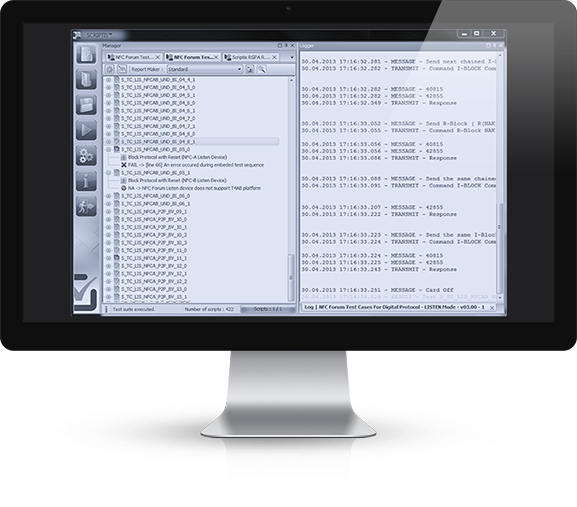EMV™ is the global standard for payment cards and readers based on contact and contactless smart card technologies. The EMV standards encompass specifications, test procedures and compliance processes managed by EMVCo1, an organisation jointly owned and operated by American Express, Discover, JCB, MasterCard, UnionPay and Visa. KEOLABS provides complete testing solutions developed and qualified in accordance with EMVCo requirements.

KEOLABS’ SCRIPTIS Analog and Digital test suites for EMVCo testing allow validation of the analog and digital-level implementations in Proximity Integrated Circuit Cards (PICC) and Proximity Coupling Devices (PCD) for use in payment applications.
The testing solutions are complemented by a complete test bench that includes EMVCo testing accessories, which are developed in strict conformance with their testing standards.

SCRIPTIS™ software is a complete, open and simple testing environment. It runs on the user’s PC and allows easy control of a range of software/hardware solutions designed for testing conformance of smart cards, card readers, related components and systems in accordance with relevant industry standards.
KEOLABS’ test suites are used in SCRIPTIS™ testing environment which facilitates testing with automation features such as visual cues and aids for manual testing, or robot integration for fully automated testing. SCRIPTIS provides full visibility of test results including logs and traces of communications between the test bench and the tested device.
EMV® CONTACTLESS TERMINAL LEVEL 1 TYPE APPROVAL1. PCD ANALOGUE EMVCo TEST SUITEThis EMVCo PCD Analogue test suite is compatible with the following standard: EMVCo PCD Level 1 Analogue Test Cases – Version 3.1a
Our coverage of this test specification includes the following test cases (numbering according to the EMVCo version 3.1a):
Radio Frequency Power
PCD to PICC Signal Interface for Type A Communications
PICC to PCD Signal Interface for Type A Communications
Bit Level Coding Signal Interface for Type A Communications
PCD to PICC Signal Interface for Type B Communications
PICC to PCD Signal Interface for Type B Communications
Bit Level Coding Signal Interface for Type B Communications
PCD IQ Demodulation for Type A Communications
PCD IQ Demodulation for Type B Communications
2. PCD DIGITAL EMVCo TEST SUITEThis EMVCo PCD Digital test suite is compatible with the following standard: EMVCo PCD Level 1 Digital Test Cases – Version 3.2a
Our coverage of this test specification includes the following test cases (numbering according to the EMVCo version 3.2a):
Type A Tests:
Type B Tests:
3. REDUCED RANGE TERMINAL ANALOGUE EMVCo TEST SUITEThis EMVCo PCD Analogue test suite is compatible with the following standard: EMVCo PCD Level 1 Analogue Test Cases – Version 3.1a EMV RR L1 Test Guidelines – Version 3.1a
This test suite also includes the EMVCo certified Scoring tool based on the “EMV Terminal Type Approval Bulletin No. 276, First Edition April 2024 – Reduced Range Devices Acceptance Criteria“.
|
EMV® CONTACTLESS CARD LEVEL 1 TYPE APPROVAL1. PICC ANALOGUE EMVCo TEST SUITEThis EMVCo PICC Analogue test suite is compatible with the following standard: EMVCo PICC Level 1 Analogue Test Cases – Version 3.2a
Our coverage of this test specification includes the following test cases (numbering according to the EMVCo version 3.2a):
PICC Power Off and Power On States Field
PICC Behavior with Respect to the Radio Frequency Field
PICC Responsiveness of a Type A PICC
Verifying the PICC Transmission for Type A
Bit Level Coding for a Type A PICC
PICC Responsiveness of a Type B PICC
Verifying the PICC Transmission for Type B
Bit level Coding for a Type B PICC
Performance Pre-verification tests
2. PICC DIGITAL EMVCo TEST SUITEThis EMVCo PICC Digital test suite is based on the standard: EMVCo PICC Level 1 Digital Test Cases – Version 3.2b
Our coverage of this test specification includes the following test cases (numbering according to the EMVCo version 3.2b):
Type A Tests:
Type B Tests:
Block Protocol Executable Tests:
3. MOBILE ANALOGUE EMVCo TEST SUITEThis EMVCo Mobile Analogue test suite is compatible with the following standard: EMVCo PICC Level 1 Analogue Test Cases – Version 3.2a EMV Mobile L1 Test Guidelines – Version 3.2a |
CARD LICENSE OPTIONS
|
READER LICENSE OPTIONS
|
PROXILAB QUEST – CONTACTLESS TESTERSC-ProxiLAB Quest: Fully programmable card (PICC), reader (PCD) and NFC signal emulator for device characterization and protocol conformance verification. ProxiLAB Quest offers the performance and features required for full characterization and conformance validation of all 13.56 MHz contactless technologies, including the latest very high bit-rate evolutions.
EMVCo ACCESSORIESKEOLABS provides the following standard compliant probes and antennas for validation of the DUT as part of the quoted validation solution:
OTHER ACCESSORIES
|
OSCILLOSCOPELECROY HDO6034-A: 12-bit ADC and Xdev options integrated into the SCRIPTIS™ based solutions to allow full control of the analog test benches for EMVCo analog-level testing.
RF AMPLIFIERBOWEN 50w – 50 Ohms: 10-250 MHz, variable gain RF signal amplifier covers the power range required by EMVCo Standard. It is also capable of amplification beyond this range for the alternating magnetic field test based on ISO14443 standard. ROBOT 6 AXIS WITH AUTOMATION SYSTEMSC-ROB6x- VS060: It allows sweeping the operating volume automatically. This robot manages the acceleration EMVCo constraints i.e. more than 8 M/s. |
